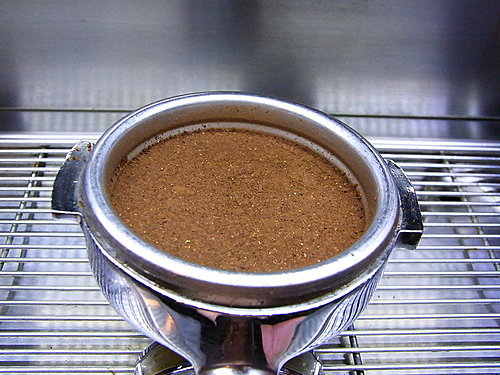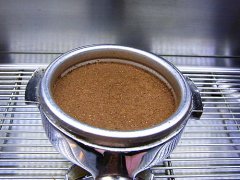Theoretical knowledge of Coffee: the principle of Coffee extraction Channel effect the effect of Coffee Channel effect on pressed powder

Professional coffee knowledge exchange more coffee bean information please follow the coffee workshop (Wechat official account cafe_style)
Why does espresso taste sour? Talking about the extraction Standard of Italian espresso
Espressos is a small, custom-made, floating layer of foam (also known as crema)
Espresso on the surface of a liquid. If you study carefully, coffee liquid and crema have emulsifying effect,
A complex system intertwined with suspension and dissolution.
The content of Crema is mainly carbon dioxide and liquid interfacial active agent (aqueous solution of).
Surfactants) film coated with air bubbles. Crema itself is also suspended with coffee cell debris.
(the main cause of "tiger spot") and emulsified lipids that give off fragrance. The contents of the coffee liquid are
Dissolved solids, emulsified lipids, suspended debris, and constantly emerging bubbles.
◎ Espresso Percolation: a Primer
Next I want to outline how espresso works. I'm not going to be very comprehensive here.
I just want to introduce some basic knowledge.
Espresso can be said to be a product under some kind of percolation. In other words, when pressurized
The hot water flows through the coffee cake, which is tightly filled with finely ground coffee powder
All you get is an espresso. When hot water flows through the coffee cakes, the solids on the surface of the coffee particles
And lipids will be dissolved and brought into the cup.
The flow rate of hot water through the coffee cake is mainly due to the pressure provided by the machine, the quality of the coffee cake, and the coffee powder.
Determined by the degree of thickness. In a way, high pressure will increase the flow rate, without those pressure flow rates.
It will go down. As for the larger amount of coffee cakes or finer coffee powder, it will form a higher water resistance and make the flow.
Slow down.
The water always follows the path of less resistance through the coffee cake, and the job of the bartender is to fill it out.
Coffee cakes with moderate amount and uniform water resistance. A poorly packed coffee cake can easily cause channel effect (channel).
In other words, there is a particularly high-speed flow of water in some areas of the coffee cake.
The channel effect has a negative effect on the concentration and flavor of coffee. A large amount of water flowing through this passage will dilute this dose.
Espresso, and causes the coffee powder around the channel to be over-extracted to increase the bitterness. And because of a smaller amount of water
Through the high residual density of the coffee cake, the extraction in these places will be insufficient, and the flavor of coffee will be suffocated.
And the concentration is relatively light.
Note: the words "excessive extraction" and "insufficient extraction" are very subjective. When I'm using these two words,
I'm not saying that there are any universal criteria in the field of coffee, tea, or espresso.
Readers should regard excessive extraction as a relative value, which is excessive extraction when the extract is higher than the expected value.
Usually to the extent that it produces too much bitterness or astringency. On the contrary, when the amount of extract is less than expected
Is the lack of extraction, generally speaking, this situation will lead to the lack of coffee flavor.
In order to avoid the channel effect as much as possible, the bartender should prepare a smooth surface,
A coffee cake that is closely integrated with the filter and has a uniform density. Sometimes (but not always) bottomless handles are used
You will see signs of the channel effect. When there is a channel effect, it indicates that the flow is intense or the velocity is uneven.
The roles of ◎ bartender, bean grinder and Italian coffee machine
The job of a bartender: when making an espresso, the basic goal of a bartender should be:
Fill each dose of espresso with coffee powder of the same quality
Choose the grinding scale that can produce the ideal flow rate.
Evenly distribute coffee powder to provide uniform water resistance
Uniform compaction of coffee cakes to eliminate internal gaps and polish the surface of coffee cakes
Make sure the hot water temperature is appropriate.
Do all the above work in an efficient manner
The role of bean grinder: of all the equipment at the espresso bar, the bean grinder is the most important equipment.
Although the bean grinder is usually overshadowed by the more expensive and shiny Italian coffee maker, it is important to prepare
There is no doubt that the quality of the bean grinder is the most important part of an excellent espresso.
A high-quality bean grinder should:
The proper particle size can be ground to provide proper water resistance.
Provide the particle size of the bimodal or triple peak distribution curve (see "Grinding for Espresso" for details)
Try not to overheat during grinding
Produce a limited amount of fine powder
Fine powder has a significant effect on the leakage of espresso, which will be described in more detail in Chapter 3.
Discuss. Now we just need to know that hot water will bring the fine powder to the bottom of the coffee cake in the process of percolation.
This phenomenon is called fine powder displacement effect (fines migration). When the coffee powder is fine and the molecule is larger
An ultra-high density powder layer is formed when insoluble proteins are deposited at the bottom of the coffee cake. This layer of ultra-high density powder
It will block the filter holes, thus hinder the progress of hot water, cause uneven water flow, and even produce channel effects.
We do need a small amount of fine powder, but too much fine powder or excessive fine powder displacement effect will
Ruined an espresso.
The role of the Italian coffee machine: the task of the Italian coffee machine is to transmit according to the predetermined temperature and pressure.
Water. These are called temperature modes and pressure modes. A good espresso machine should be used even if you use it.
Even at high frequency, it can still provide a stable temperature and pressure mode for each dose of espresso.
There are two other chapters in the book, "The Phases of Espresso Percolation".
"Brew Strength and Yield: Espresso"
--
The proper noun is really the devil T.T.
.
Important Notice :
前街咖啡 FrontStreet Coffee has moved to new addredd:
FrontStreet Coffee Address: 315,Donghua East Road,GuangZhou
Tel:020 38364473
- Prev

Can the refill pressure of Italian coffee avoid the channel effect? Will the latter part of Italian extraction be over-selected?
Professional coffee knowledge exchange more coffee bean information please follow the coffee workshop (Wechat official account cafe_style) Italian espresso how to drink sour and astringent taste? Why is the extraction standard of espresso stuffed duck? Because when teaching coffee, most people are only taught to fill the coffee, not to tilt to one side, not to tilt to one side, to let the filler and filter.
- Next

How to avoid coffee channel effect in the later stage of Italian extraction? To learn about the soul of espresso.
Professional coffee knowledge exchange more coffee bean information please follow the coffee workshop (Wechat official account cafe_style) Italian espresso how to drink sour and astringent taste? Talk about the extraction standard of espresso Espresso originated in Italy, and fashion, food is regarded as Italy's three national treasures, known as the soul of coffee. For a coffee shop, not if you don't sell this drink.
Related
- What is the meaning of lactic acid fermentation with coffee bean treatment?
- How to judge the state of foam by sound?
- How does the latte pull out the unicorn pattern? Come to get for a little trick to improve the flower pull!
- Will flower pulling affect the taste of the latte?
- Do you know the history of coffee?
- The difference between honey treatment and sun washing what is raisin honey treatment?
- What kind of milk can a novice use to make coffee foam to keep the foam longer? The correct method and skills of milking tutorial sharing
- Why do washed coffee beans taste sour? Flavor characteristics of washed Coffee
- Introduction to the skill of how to practice the size and height of water injection around the circle of hand-brewed coffee
- How do beginners practice coffee flower drawing from scratch?

